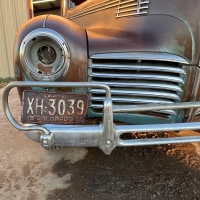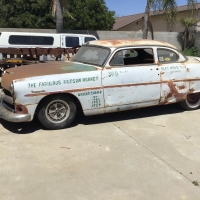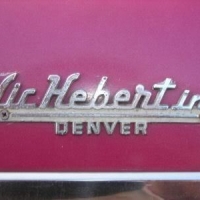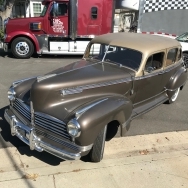Problem list of 53 Hornet
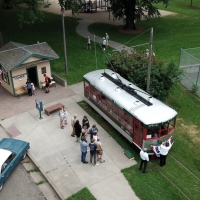
50SuperFalcon
Member
Hello all ,
here are the problems I’m having with my 53 Hornet .Thanks in advance for any assistance!!
As I write this I’m finding a lot of these problems are interrelated so sorry if this sounds repetitive.
4 anybody know how to repair the clocks? (I’m a clockmaker by trade but I’m not to well trained in electromechanical stuff) are they repairable ?
5 My rear window leaks like a siv and I haven’t a headliner should all that be replaced at the same time?
6 My good is from what I can find bent , the pass. side front sits as it should but the driver side sits up some 3/4-1” . How does one go about fixing that?
7 the brakes are rather soft , and only start to engage on the bottom end on the stroke . It engages 1-2” before the mechanical take over , but are soft non the less(brand new master cyl)
what can be done to stiffen these up or is this just a Hudson thing ??I have a 65 Ford Falcon and it is as hard as nails 1-1.5 in down .
Ill be adding things as I think of them with a continuation of digits .
Hudsonly,
Blake
here are the problems I’m having with my 53 Hornet .Thanks in advance for any assistance!!
1 I am having difficulty getting the car to idle smoothly at a low rpm .carbs where just rebuilt and cleaned. Has twin h ,headers and has a hydramatic. If I’m not mistaken it should idle around 800 and in gear 600 but at the altitude I live at (5000 ft) it should be a touch higher .(I do take drives into the hills often)
2 one of the header pipes is hitting the frame at the rough idle in gear . And it sounds like my car is rattling to peices😡. Do I bend the exhaust or try harder on item #1 and smooth it out ?
3 my fuel economy is rather poor , 10-13 , from what I hear I should be getting 18 on the highway . I’m happy with 16 and higher but it’s kind of a pain to get that.
3.5 I’ll be driving and after it shifts into 3rd it will sometimes just start spuddering and I just can’t get it to go it just wants to sit and cough . What is going on with this?
2 one of the header pipes is hitting the frame at the rough idle in gear . And it sounds like my car is rattling to peices😡. Do I bend the exhaust or try harder on item #1 and smooth it out ?
3 my fuel economy is rather poor , 10-13 , from what I hear I should be getting 18 on the highway . I’m happy with 16 and higher but it’s kind of a pain to get that.
3.5 I’ll be driving and after it shifts into 3rd it will sometimes just start spuddering and I just can’t get it to go it just wants to sit and cough . What is going on with this?
As I write this I’m finding a lot of these problems are interrelated so sorry if this sounds repetitive.
4 anybody know how to repair the clocks? (I’m a clockmaker by trade but I’m not to well trained in electromechanical stuff) are they repairable ?
5 My rear window leaks like a siv and I haven’t a headliner should all that be replaced at the same time?
6 My good is from what I can find bent , the pass. side front sits as it should but the driver side sits up some 3/4-1” . How does one go about fixing that?
7 the brakes are rather soft , and only start to engage on the bottom end on the stroke . It engages 1-2” before the mechanical take over , but are soft non the less(brand new master cyl)
what can be done to stiffen these up or is this just a Hudson thing ??I have a 65 Ford Falcon and it is as hard as nails 1-1.5 in down .
Ill be adding things as I think of them with a continuation of digits .
Hudsonly,
Blake
0
Comments
-
Blake, I can help with your clock if you want to send it to me I can repair it. The rear window seal can come from Doug Wildrick at Wildrick restorations. The headliner can come from Acme Headliners in Long Beach, CA. They only go through distributors but any local trim shop should be able to get that. It is imperative that you put the headliner in BEFORE you seal up the rear window. On your brakes, check your hoses, old hoses can collapse from inside like radiator hoses . If you are still using old origional steel brake lines look for splits and clogs in the old lines. Brass unions can have hairline cracks from aging as well .Also, check wheel cylinders for leaks otherwise you may just need to bleed the system again. Adjusting the hood is a bit tricky. There are adjustments that can be made on the rear hinges but only slightly. The front bump stops on the tie panel can also be adjusted up and down.0
-
@Lance I will take a look at all written . I’ll message you with regards to the clock0
-
In addition to what Lance said about your brakes, make that they are adjusted properly. If the air is out of the system and adjusted right it will stop smooth and straight with a high hard pedal.As far as the engine, check compression so that it relatively equal, make sure ignition is in good shape, check and set the points and then check and set the ignition timing. Make sure you don’t have any vacuum leaks. In your altitude you can give the ignition a couple more degrees of advance, just no pinging.0
-
I highly recommend removing the distributor, and doing the points on the bench. The distributor only fits into the oil pump one way, (the gear is on the pump, and the distributor has an offset tang that fits in a slot on the pump), so just see what the timing is set at on the scale under the locking screw so you can put it back in where it was, as a starting point for making adjustments after your new parts are in it.0
-
@cheyenne7271 how does one adjust the brakes? Is this an adjustment at the drum?
I know the timing is a little retarded than what it should be right now.
@54coupe the distributor that’s in it has an unknown about of miles on it due to the previous owner taking out the stock dis and leaving off the vac advance off. Uggg what a pain that was to drive. You are right it does need to be gone through .
0 -
The backing plates have over shaped holes that accept a brake adjuster or a flat screwdriver will also do. You can look inside of the hole and see the star wheel, rotate the wheel down as you look at it to make the brakes tighter, while rotating the tire. Your listening for a slight drag of the shoes to the drums0
-
Did you replace the non-stock dizzy with a Hudson version, or is it still a non-stock one?0
-
Are you running regular brake fluid, or silicone? I have been using silicone for maybe 30 years, and -- while I wouldn't call my brakes "soft", neither are they "hard as nails". But they stop the car just fine. As you certainly know, if you place your foot on the brake pedal and it slowly moves toward the floorboard, THEN you have a problem!
The clock winds itself with an electromagnet, which pulls the winding lever around (thus tightening the spring). When the winding lever has unwound, it triggers the electric points, which send a fresh charge to the electromagnet, thus starting the whole process again. If you sit in a car with this type of clock, you hear a "thunk" every 4-5 minutes as the thing winds itself. Remove the cover to see the clockwork and winding mechanism. Rotate the winding lever manually and the clock should start to tick. (If it doesn't....well...you're the clockmaker!) The problem is that the points need filing, OR a wire has heated up and come unsoldered. File the points first, hook to a 6-volt power source, and see if the thing works. If not, carefully study the wiring for a bad connection. The electromagnetic winder is primitive, thus easy to fix.0 -
I have a 1953 Craftsman (Sears) "Mechanics' Tools" catalog. It lists their brake adjusting tool (brake spoon) # 4740 as "Fits 1936-50 GM cars; also Hudson and others." This brake tool can generally be found in on-line auctions at a nominal price.0
-
@cheyenne7271 thanks for that! I will do so next time she’s on the lift .@superwasp I have the stock 308 1953 dizzy in it now .
@Jon B standard old fluid .3 if I remember correctly.
This helps a lot of people greatly , including myself! Thank you greatly!!!!!
@railknight I shall look for one, and see if I can add it to my collection.
Thanks again!Blake0 -
NAPA still sells the brake spoons. Harbor Freight shows a set of brake tools for $200
-
Thoughts about car clocks.
Imagine the environment that they operate in. Unlike a house clock, they are not in a protected environment. A summer day can run interior temperatures over 120 degrees. Winter can plunge them below freezing. Now imagine all that expansion-contraction between the many critical gear clearances. Not to mention the temperature effects on the lubricants.
A car clock also does not sit on a stable shelf. It is subjected to a significant amount of vibration. A balance wheel would have its hands full dealing with that.
I have not mentioned the dust and dirt that is inevitable behind the dashboard.
It is a wonder that any car clocked worked for longer than a year when new.
Want to fix yours?
(Except for those that are hand wind) Remember a car clock uses battery power. If a car is parked for a long time the clock represents a parasitic battery drain and while not much, it will kill a battery over time.
As the battery drains the voltage drops and can require higher amps to rewind the spring, which can increase the park and pitting on the points.
Quartz conversions overcome some of these failings and is why many car clocks are commonly converted.
Car clocks are cute. A working one is necessary for a 100 point car, but the novelty of having a working clock can quickly be supplanted by the increased maintenance to keep one working.0 -
Brakes. Unless you have a 100% reliable history of repair and recent maintenance of THE ENTIRE SYSTEM you must assume that your system is completely shot, do not trust it!
Before driving any "old car" that I get, I automatically pull all 4 wheels and replace ALL hydraulic components. 4 wheel cylinders, 3 new brake hoses and the master cylinder.
Brake hoses are to be replaced NOT just inspected. They may/may not have cracks on the outside BUT they more commonly swell up on the inside and stop the flow of fluid. You cannot see this on inspection. Just replace all three.
Good source for hoses: call Nick Christman at www.brakehosesunlimited.biz
All brake lines are then inspected their entire length (rust? cracks? remove the clips to inspect under them) and flushed (blow them out or sometimes a good bleed) Then refill with new fluid.
(DOT 3? DOT 5? I will leave those debates for other postings)
The shoes are rarely bad. Commonly they were in good shape when the car was last used. I inspect them and clean them up (and the drum) with sandpaper. Unless badly worn they are generally reusable.
Reinstall and adjust the system properly as per the shop manual.
While I am in there, it is also the time to repack the bearings and replace the seals.
New basic hydraulic parts; Wheel cylinder (kits or complete) new hoses and master cylinder will typically cost $200 - $300. This is extremely cheap compared to the cost involved in a brake failure.
NOTE: There is NO SHORT CUT here!
Brakes are your #1 safety item. you cannot have them function too well.
If they fail, it will be catastrophic for you and the car.
FYI Hudsons do need a special puller to remove the rear drum from the tapered axle. (Not a 3 jaw puller!) These drum pullers can be found on eBay for not much money. If you are going to be a Hudson owner it is a tool you will need.
0
Categories
- 36.9K All Categories
- 113 Hudson 1916 - 1929
- 20 Upcoming Events
- 92 Essex Super 6
- 28.6K HUDSON
- 574 "How To" - Skills, mechanical and other wise
- 995 Street Rods
- 151 American Motors
- 178 The Flathead Forum
- 49 Manuals, etc,.
- 78 Hudson 8
- 44 FORUM - Instructions and Tips on using the forum
- 2.8K CLASSIFIEDS
- 608 Vehicles
- 2.2K Parts & Pieces
- 77 Literature & Memorabilia
- Hudson 1916 - 1929 Yahoo Groups Archived Photos
